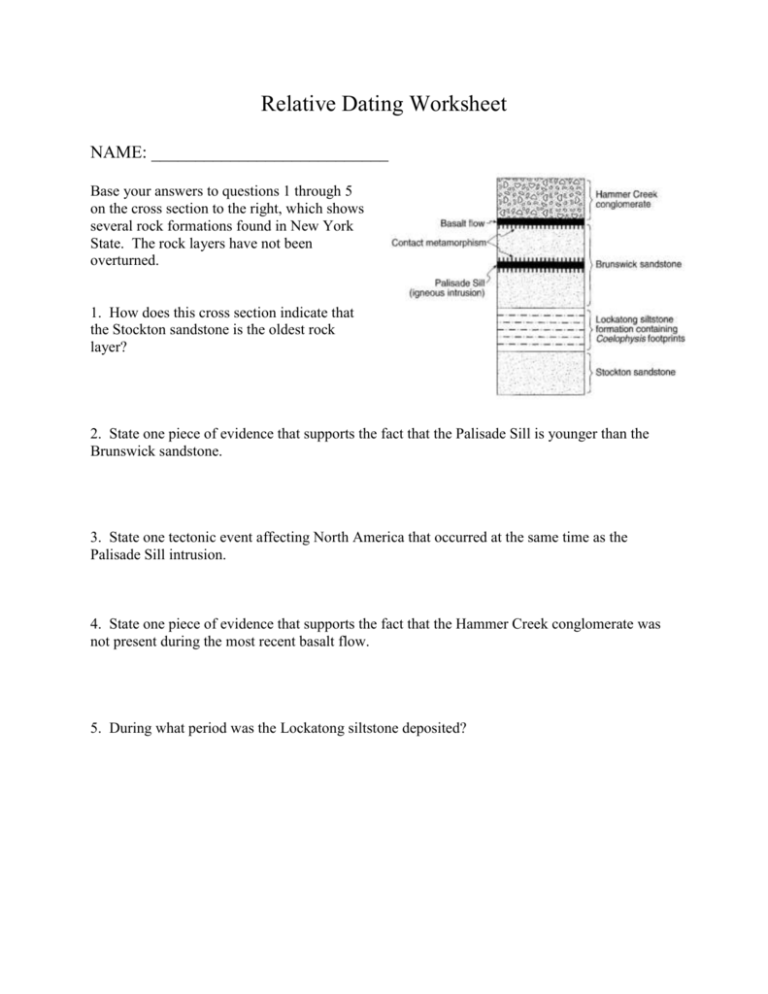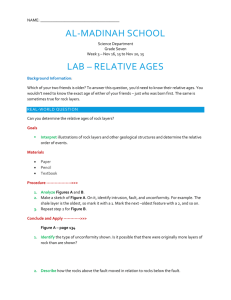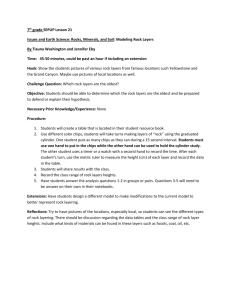Review Worksheet On Relative Dating And Index Fossils
advertisement

Relative Dating Worksheet NAME: ___________________________ Base your answers to questions 1 through 5 on the cross section to the right, which shows several rock formations found in New York State. The rock layers have not been overturned. 1. How does this cross section indicate that the Stockton sandstone is the oldest rock layer? 2. State one piece of evidence that supports the fact that the Palisade Sill is younger than the Brunswick sandstone. 3. State one tectonic event affecting North America that occurred at the same time as the Palisade Sill intrusion. 4. State one piece of evidence that supports the fact that the Hammer Creek conglomerate was not present during the most recent basalt flow. 5. During what period was the Lockatong siltstone deposited? Base your answers to questions 6 through 9 on the cross section below. The cross section shows a portion of Earth’s crust. The age, in millions of years, of each boundary between the different sedimentary rock layers is shown. The age of boundary X between the sedimentary rock and the metamorphic rock is not shown. Assume no overturning has occurred. 6. Identify the geologic feature represented by boundary X. 7. Name two processes that were involved in the formation of boundary X? 8. Describe how the rock type below boundary X was formed. 9. Identify by name one index fossil that existed when the limestone rock shown in the cross section was being formed. The cross section to the right shows a rock sequence that has not been overturned. 10.______ Which event occurred last at this location? (1) Shale was deposited. (2) Glacial till was deposited. (3) Basaltic lava flows solidified. (4) Glossopteris flourished and then became extinct. The block diagram to the right shows a portion of Earth’s crust. Letters A, B, C and D indicate sedimentary rock layers. 11.______ Which event occurred most recently? (1) formation of layer A (2) formation of layer D (3) tilting of all four sedimentary rock layers (4) erosion of the igneous rock exposed at the surface The cross section to the right shows rock layers A, B, C and D. The rock layers have not been overturned. 12.______ Which sequence places the rock layers and fault in order from oldest to youngest? (1) D>C>B>A>F (2) A>B>C>D>F (3) F>D>C>B>A (4) F>A>B>C>D The geologic cross section to the right shows a complex structure containing a granite intrusion. 13.______ If the granite intrusion occurred 24 million years ago, what are the most probable ages of the schist and shale, in millions of years? (1) schist - 25; shale – 23 (2) schist – 25; shale – 26 (3) schist – 23; shale – 25 (4) schist – 23; shale – 20 Base your answers to questions 14 through 16 on the cross sections below, which show widely separated outcrops labeled I, II, and III. Index fossils are found in some of the layers in the three outcrops. In outcrop III, layers A, B, C and D area labeled. Line XY represents an unconformity. Line GH represents a fault. 14. On the outcrop to the right draw a thick line for an unconformity between the two rock layers where the Silurian-age bedrock has been removed by erosion. 15. Describe one characteristic necessary for a fossil to be classified as an index fossil. 16. List in order, from oldest to youngest, the relative age of the four rock layers A, B, C and D, fault GH, and unconformity XY shown in outcrop III. ___________ ___________ __________ OLDEST ___________ ___________ ___________ YOUNGEST







